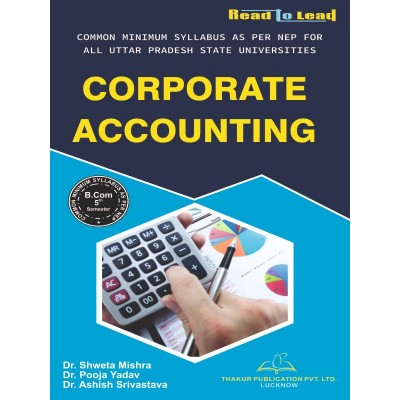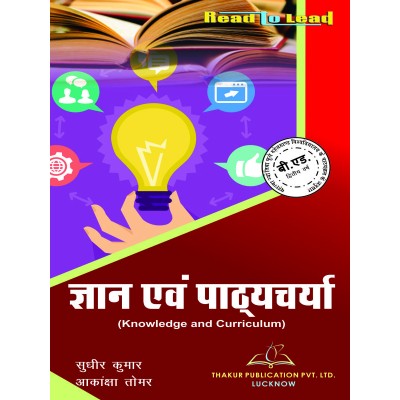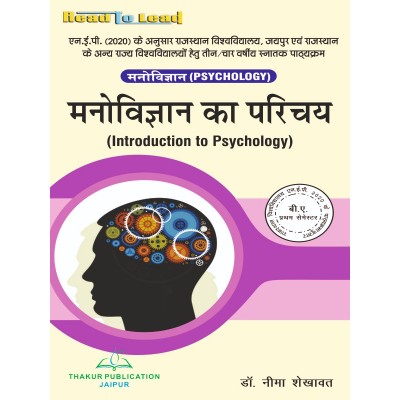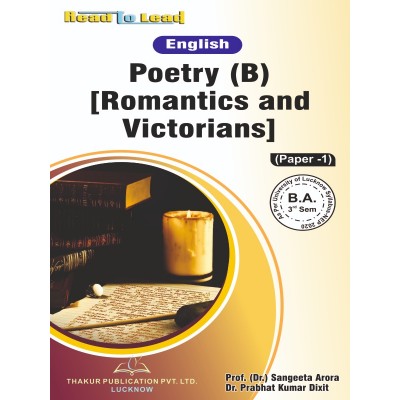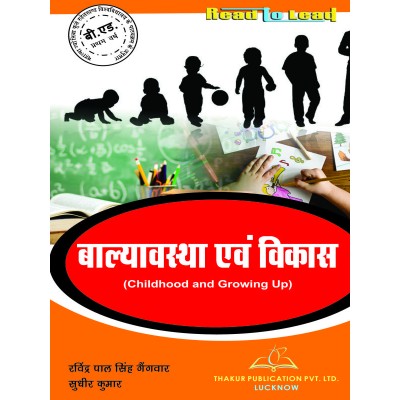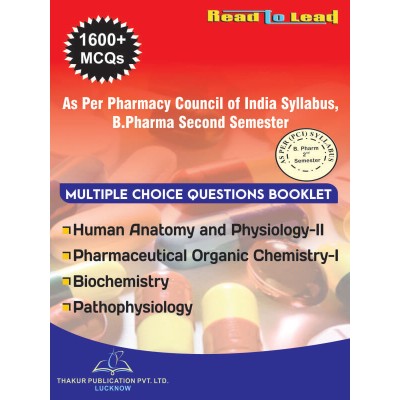Categories
- Pharmacy
-
Nursing
-
MBA
-
BBA
- U.P. State University
- Veer Bahadur Singh Purvanchal University, Jaunpur
- Chaudhary Charan Singh University, Meerut
- Dr. Bhimrao Ambedkar University, Agra
- Chhatrapati Shahu Ji Maharaj University, Kanpur
- Mahatma Jyotiba Phule Rohilkhand University, Bareilly
- Mahatma Gandhi Kashi Vidyapith, Varanasi
- Dr. Ram Manohar Lohia Avadh University, Ayodhya
- Deen Dayal Upadhyaya Gorakhpur University
- Prof. Rajendra Singh (Rajju Bhaiya) University, Prayagraj
-
BCA
- UP State Universities
- University of Pune
- I.K.Gujral Punjab Technical University (PTU)
- University of Rajasthan
- Rashtrasant Tukadoji Maharaj Nagpur University
- Uttar Pradesh NEP2020
- University of Rajasthan ,Jaipur (According to NEP-2020)
- BCCA (B. Com - Computer Science)
- Haryana
- West Bengal
- BBA (CA)
- PUNE BCA (Sci,Commerce)/B.Com (CA)
- Dr. A. P. J. Abdul Kalam Technical University, Lucknow ( AKTU )
- MCA
-
B Ed
- Lucknow University B.Ed Books
- Chaudhary Charan Singh University/Maa Shakambhari University, Saharanpur
- Dr Bhim Rao Ambedkar University, Agra
- Mahatma Gandhi Kashi Vidyapeeth, Varanasi
- Chhatrapati Shahu Ji Maharaj University
- Prof. Rajendra Singh (Rajju Bhaiya) University, Prayagraj (PRSU)
- Mahatma Jyotiba Phule Rohilkhand University(Mjpru), Bareilly
- Dr. Ram Manohar Lohia Avadh University, Ayodhya
- Bundelkhand University, Jhansi
- B.A,B.ed
- B.Sc, B.ed
- Deen Dayal Upadhyaya Gorakhpur University
- Veer Bahadur Purvanchal University (VBPU)
- Maharaja Suhel Dev State University ,Azamgarh (MSDSU)
- Raja Mahendra Pratap Singh State University, Aligarh (RMPSSU)
- Barkatullah Vishwavidyalaya (Bhopal)
- Jiwaji University (Gwalior)
- Vikram University (Ujjain)
- Dr. Harisingh Gour University (Sagar)
- Devi Ahilya Vishwavidyalaya (Indore)
- Rani Durgavati Vishwavidyalaya (Jabalpur)
- Awadhesh Pratap Singh University (Rewa)
- Maharaja Chhatrasal Bundelkhand University (Chhatarpur)
- D. EL. ED
- TET
-
B Com
-
B Sc
- B.Sc. U.P. State Universities Common Syllabus NEP
- Veer Bahadur Singh Purvanchal University, Jaunpur
- University of Lucknow
- Chaudhary Charan Singh University, Meerut
- Madhya Pradesh
- Chhatrapati Shahu Ji Maharaj University, Kanpur
- Dr. Bhimrao Ambedkar University, Agra
- Mahatma Gandhi Kashi Vidyapith, Varanasi
- DEEN DAYAL UPADHYAYA GORAKHPUR UNIVERSITY
- Prof. Rajendra Singh (Rajju Bhaiya) University, Prayagraj
- Dr. Ram Manohar Lohia Avadh University, Ayodhya
- Mahatma Jyotiba Phule Rohilkhand University, Bareilly
- Uttarakhand State Universities
- B.Sc. Bihar Universities Common Syllabus NEP
- University of Rajasthan (Jaipur)
- Haryana
-
Bachelor of Arts [B.A.]
- B.A. Of U.P. State Universities Common Syllabus NEP
- Veer Bahadur Singh Purvanchal University, Jaunpur
- University of Lucknow
- Chaudhary Charan Singh University, Meerut
- Chhatrapati Shahu Ji Maharaj University, Kanpur
- Dr. Bhimrao Ambedkar University, Agra
- Mahatma Gandhi Kashi Vidyapith, Varanasi
- Deen Dayal Upadhyaya Gorakhpur University
- Prof. Rajendra Singh (Rajju Bhaiya) University, Prayagraj
- Dr. Ram Manohar Lohia Avadh University, Ayodhya
- Mahatma Jyotiba Phule Rohilkhand University, Bareilly
- Madhya Pradesh
- Uttarakhand
- Bihar
- University of Rajasthan (Jaipur Syllabus as Per NEP2020)
- Haryana NEP-2020
- B Tech
- LLB
- SWA Education
(Botany) Plant Taxonomy And Ecology B.Sc 2nd Semester
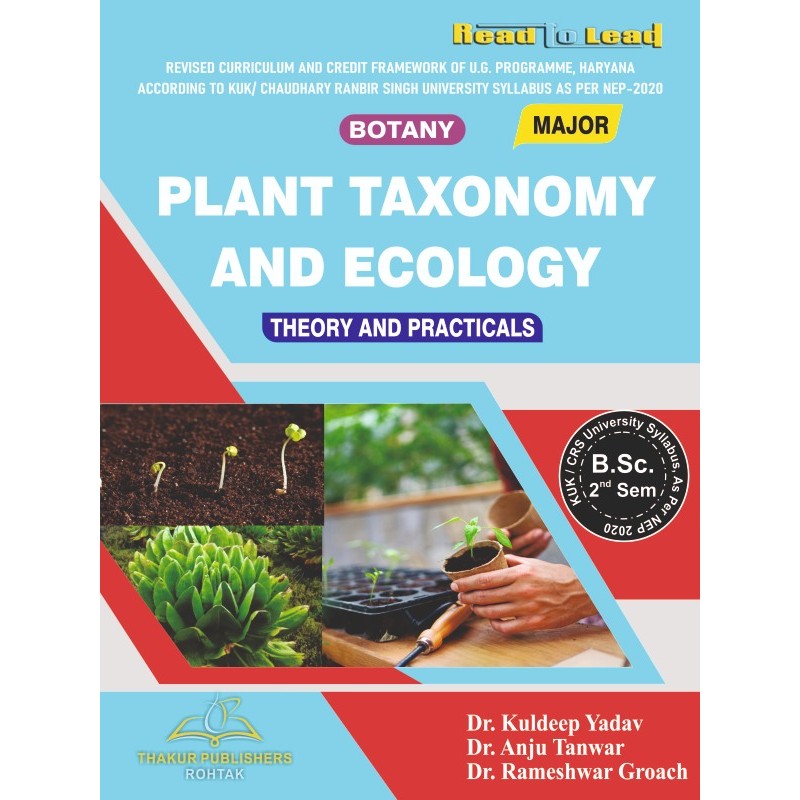
Buy Latest (Botany) Plant Taxonomy And Ecology (Major) Book in English Language for B.Sc 2nd Semester KUK/CRS University NEP-2020 By Thakur publication.Written by Experienced Authors | Fast & All India Delivery |
AUTHORS: Dr. Kuldeep Yadav , Dr. Anju Tanwar, Dr. Rameshwar Groach
ISBN : 978-93-5755-703-0
Tax excluded
Buy Latest (Botany) Plant Taxonomy And Ecology (Major) Book in English Language for B.Sc 2nd Semester KUK/CRS University NEP-2020 By Thakur publication.Written by Experienced Authors | Fast & All India Delivery |
AUTHORS: Dr. Kuldeep Yadav , Dr. Anju Tanwar, Dr. Rameshwar Groach
ISBN : 978-93-5755-703-0
Syllabus
Botany (Plant Taxonomy and Ecology)
Course Code: B23-BOT-201
|
Unit |
Topic |
Hrs.
|
|
I
|
Botanical Nomenclature and major rules of ICBN and ICN; Keys to Identification of Plants. General Introduction and Importance of Herbaria and Botanical Gardens. Documentation of Floristic Diversity: Brief idea about floras, monographs and journals. Brief idea of taxonomic evidences. Types of inflorescence, flower and parts of flower. |
11 |
|
II |
Artificial, natural and phylogenetic classifications. Bentham and Hooker system of classification (upto series), Angiosperm Phylogeny Group- general account.
Diagnostic Features and Economic Importance of the Following Families: Ranunculaceae, Brassicaceae, Malvaceae, Euphorbiaceae, Rutaceae, Leguminosae, Apocynaceae, Lamiaceae, Solanaceae, Asteraceae, Poaceae, and Orchidaceae. |
12 |
|
III |
Ecology: Definition; scope and importance; levels of organisation. environmental factors- climatic factors, edaphic factors, topographic; and biotic factors. Population Ecology: Basic concept; characteristics; biotic potential, growth curves; ecotypes and ecads. Community Ecology: Concepts; characteristics (qualitative and quantitative-analytical and synthetic); methods of analysis; ecological succession. |
11 |
|
IV |
Ecosystem: Structure and functions (trophic levels, food chains, food webs, ecological pyramids, and energy flow). Phyto-geography: Phyto-geographical regions of India; vegetation types of India (forests). Environmental Pollution: Sources, types, and control of air and water pollution. Global Change: Greenhouse effect and greenhouse gases; impacts of global warming; carbon trading. Biodiversity: Levels, types, significance, threats, and conservation. |
11 |
|
V* |
· Study of Instruments Used to Measure Microclimatic Variables: Soil thermometer, maximum and minimum thermometer, anemometer, psychrometer/hygrometer, rain gauge, and lux meter. · Determination of pH, and analysis of two soil samples for carbonates, chlorides, and sulphates by rapid field test. · Comparison of bulk density, porosity and rate of infiltration of water in soil of three habitats. · To determine inorganic carbon content of given soil samples. · To determine organic carbon content of given soil samples by acid dilution method. · (a) Study of morphological adaptations of hydrophytes and following: Stem parasite (Cuscuta), Root parasite (Orobanche), Epiphytes (Orchid) and Predation (Insectivorous plants) using museum specimens/ live plants. · Determination of minimal quadrat size for the study of herbaceous vegetation in the college campus or nearby fields by species area curve method (species to be listed). · Quantitative analysis of herbaceous vegetation in the college campus or nearby fields for frequency and comparison with Raunkiaer’s frequency distribution law. · Study of vegetative and floral characters of the one or two member of each family/sub-family mentioned in theory syllabus (Description, V.S. flower, section of ovary, floral diagram/s, floral formula/e and systematic position according to Bentham & Hooker’s system of classification). · Excursion Report: Report on excursion tours with photographs, collection, preservation and preparation of herbarium sheets and specimens related to Angiosperms. Mounting of a collected, properly dried and pressed specimen of minimum 20 wild plants with herbarium label. |
30 |
16 other products in the same category:
Your review appreciation cannot be sent
Report comment
Report sent
Your report cannot be sent
Write your review
Review sent
Your review cannot be sent









